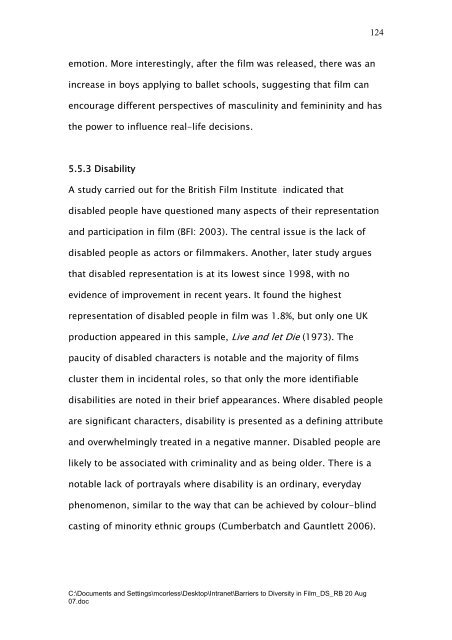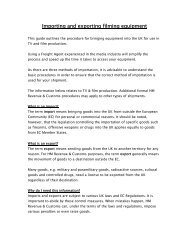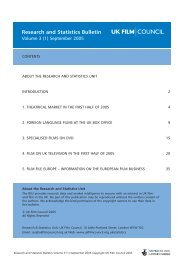Barriers to Diversity in Film – A Research Review – Aug 07
Barriers to Diversity in Film – A Research Review – Aug 07
Barriers to Diversity in Film – A Research Review – Aug 07
Create successful ePaper yourself
Turn your PDF publications into a flip-book with our unique Google optimized e-Paper software.
emotion. More <strong>in</strong>terest<strong>in</strong>gly, after the film was released, there was an<br />
<strong>in</strong>crease <strong>in</strong> boys apply<strong>in</strong>g <strong>to</strong> ballet schools, suggest<strong>in</strong>g that film can<br />
encourage different perspectives of mascul<strong>in</strong>ity and fem<strong>in</strong><strong>in</strong>ity and has<br />
the power <strong>to</strong> <strong>in</strong>fluence real-life decisions.<br />
5.5.3 Disability<br />
A study carried out for the British <strong>Film</strong> Institute <strong>in</strong>dicated that<br />
disabled people have questioned many aspects of their representation<br />
and participation <strong>in</strong> film (BFI: 2003). The central issue is the lack of<br />
disabled people as ac<strong>to</strong>rs or filmmakers. Another, later study argues<br />
that disabled representation is at its lowest s<strong>in</strong>ce 1998, with no<br />
evidence of improvement <strong>in</strong> recent years. It found the highest<br />
representation of disabled people <strong>in</strong> film was 1.8%, but only one UK<br />
production appeared <strong>in</strong> this sample, Live and let Die (1973). The<br />
paucity of disabled characters is notable and the majority of films<br />
cluster them <strong>in</strong> <strong>in</strong>cidental roles, so that only the more identifiable<br />
disabilities are noted <strong>in</strong> their brief appearances. Where disabled people<br />
are significant characters, disability is presented as a def<strong>in</strong><strong>in</strong>g attribute<br />
and overwhelm<strong>in</strong>gly treated <strong>in</strong> a negative manner. Disabled people are<br />
likely <strong>to</strong> be associated with crim<strong>in</strong>ality and as be<strong>in</strong>g older. There is a<br />
notable lack of portrayals where disability is an ord<strong>in</strong>ary, everyday<br />
phenomenon, similar <strong>to</strong> the way that can be achieved by colour-bl<strong>in</strong>d<br />
cast<strong>in</strong>g of m<strong>in</strong>ority ethnic groups (Cumberbatch and Gauntlett 2006).<br />
C:\Documents and Sett<strong>in</strong>gs\mcorless\Desk<strong>to</strong>p\Intranet\<strong>Barriers</strong> <strong>to</strong> <strong>Diversity</strong> <strong>in</strong> <strong>Film</strong>_DS_RB 20 <strong>Aug</strong><br />
<strong>07</strong>.doc<br />
124
















